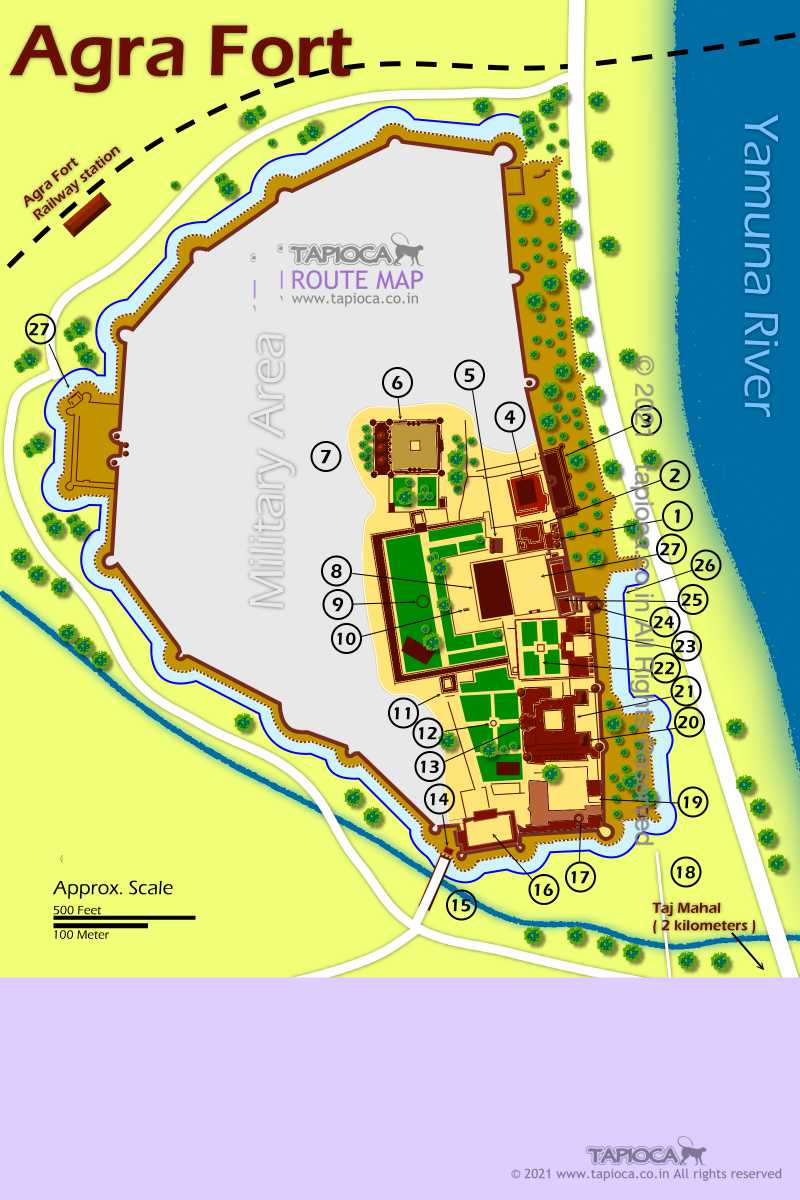Agra Fort
Taj overshadows this otherwise majestic and historically far more important attraction in Agra.

Agra Fort seen from the outside
Agra Fort seen from the outside
A
gra Fort's biggest challenge is the Taj Mahal...from a tourism perspective.If one is to list the surviving structures, that had profound role in shaping the medieval history of India, probably Agra Fort tops the list.
In other words , if you make a who's who of the Mughal Emperors, more than half a dozen Emperors - Babur, Humayun, Akbar, Jehangir, Shah Jahan and Aurangzeb - all lived in the Agra Fort.
Agra Fort is no mausoleum. I was a strong hold , the administrative headquarters, the royal palace , the court , and even a bazar .... all boiled into one giant imperial enclave. It gives a close view how the Mughals lived, how their living rooms look like, how magnificent their private gardens and mosques were. In short a visit to Agra Fort is like visiting the private homes and courts of the bygone emperors. And it is very easy to get the feel of their daily life in the grand and ordinary corridors of their living quarters.
First a short historical background of Agra Fort. As a medieval place Agra has more the 25 centuries history. But the its prominence started in 1504 when the Delhi Sultan Sikandar Lodi founded the city on the banks of Yamuna. Later his son Sultan Ibrahim Lodi made it into the capital of Delhi Sultanate.
Babur , the first of the Mughal emperors sent his son Humayun to attack Agra Fort. Agra remained as the capital of Delhi Sultanate till 1526 when Ibrahim Lodi was defeated and killed in the battle of Panipat in 1526.
That practically marked the beginning of Mougal Empire in India. The war booty included the largest diamond ever - Koh-i-Noor literally means the Mountain of Light. In those days the brick made Agra fort was Badalgarh. Babur stayed in the palace of Ibrahim Lodhi inside the fort. He added a number of structures to the fort. Most prominent is a stepwell.
Strategically Agra's location was more advantageous than Delhi. And the Agra Fort was located at a vantage point on the southern banks of the River Yamuna. The river served two purposes -ample of water supply to the royal quarters and it acted as a formidable natural barrier against an invading army. Every ruler from now onwards including the British , used it to their advantage.
From now one the Agra fort has seen many renovation and new constructions by all the subsequent Mughal rulers. Some of the important and earliest structures one can see now at Agra Fort were built during this time.
Three years later in 1529 Humayun was coronated as the second Mughal Emperor in Agra Fort . A series of conquests followed. One was his march to Bengal to defeat Sher Shah Suri. Tricked by Sher Shah's war tactics and the conspiracy hatched by his own brothers, Humayun had to fled Agra. Sher Shah then captured Agra Fort and made it into a garrison. That was in year 1540 , ten years after he was crowned in Agra Fort.
For another fifteen years he had to wander mostly in Rajasthan , Sindh and in Persia before recapturing his throne. At Umarkot of Sindh now in Pakistan , he married Hamida Banu. A son was born to the exiled couple. He was Akbar who later became the greatest Mughal emperor.
The fleeing Humayun had to jump into a river (Ganges) to save his life from the soldiers of the victorious Sher Shah. A water carrier saved him from drowning. Later Humayun made him the emperor - albeit for half a day - as a symbolic gesture to save his life. This happened inside the Agra Fort. Humayun later died in Delhi , after a fall from a staircase in his library.
Young Akbar ascended the throne and arrived in Agra. Akbar in fact added considerable features to Agra Fort to its present form. It took him 8 years (1565-1573) and 4000 workers to built the whole fort with red sand stone , that is abundant in the region. That was more than 80 years before Taj Mahal was completed by Shah Jahan , grandson of Akbar. It was during the Akbar's time that the fort premises turned into a palatial complex as much as a military stronghold.
A section of the palace is named after Akbar. The Bengali Mahal is long majestic sandstone built palace. His son, Jahangir has brought down a portion of it to rebuild a palace of his own liking. The Bengali Mahal palace has two portions, the older part in the south is called Akbari Mahal and the portion built by Jahangir is called Jahangiri Mahal.
An important feature of the Agra Fort is the southern gate called Akbari Gate and the western gate called Delhi Gate.
Jahangir later renamed the Akbari Gate as Amar Singh Gate, after the Rathore king. Though a tolerant ruler as his father, Jahangir lacked the diplomatic shrewdness Akbar possessed. His most irksome for was the Amar Singh of Mewar. It's a story of foe-turned-ally-turned-foe. The legend is that Amar Singh rode his horse over the ramp and across the moat near this gate. The horse died in the fall , but the king escaped. For the second time however , he was not successful and got arrested and executed. And hence the name Amar Singh Gate.
Jahangir was born in Fatehpur Sikri , the new capital city Akbar built west of Agra. As the king Jahangir lived mostly in Lahore ( now in Pakistan) and in Kashmir. During his frequent visits to Agra , he stayed in Agra Fort.
After Jahangir, his third son Shah Jahan became the emperor 1628. Shah Jahan is more popular for he who constructed Taj Mahal just a stone's throw distance from Agra Fort. The red sandstone structures inside the Agra Fort gave way to sparkling white marble.
The three mosques inside Agra Fort Moti Masjid, Nagina Masjid and Mina Masjid were built by him. So is the much popular Peacock Throne. It was studded with Koh-i-Nur located inside Diwani-i-Am of Agra Fort.
Shah Jahan later shifted the capital to Delhi. But continued to live - got imprisoned by his son , to be precise - in Agra Fort.
Once Shah Jahan moved the capital from Agra to Delhi , the importance of Agra Fort started falling slowly by steadily. Aurangzeb , his rebellious son took power rather forcefully in 1658.
It was reduced to a military bastion than of a palace. The additions of Aurangzeb to Agra Fort were mostly military ones. The circular barbicans around the Delhi Gate, Amar Singh Gate and the ones facing the river side were executed under the orders of Aurangzeb.
His ailing father , Shah Jahan was put under house arrest in Agra Fort. Later in 1666 , Shivaji the Marata king met Aurangzeb in the Diwan-i-Khas of Agra Fort.
Shah Jahan lived in a quarter facing the river. He spend his time looking at the mausoleum ( that is Taj Mahal) he made for his beloved wife Mumtaz Mahal. Form this octagonal tower with balcony Taj can be seen on the banks of Yamuna. The tower is known as Musamman Burj. It's told that Aurangzeb even sealed a part of this to prevent Shah Jahan seeing the Taj! He died after 8 years in imprisonment. Now onwards Agra Fort was no more a power center.
The fact is the power of Mughals itself was beginning to weaken during this period. Aurangzeb spend most of his time in losing battles. Though the dynasty continued many generations, they were no more feared or respected powers.
For quite some time the later Mughal kings were under the dominion of the Marata kings and then puppets in the hands of the British East India Company.
Agra Fort too metamorphosed accordingly. While the Mughals were its builders, the later occupants were more interested in plundering the wealth or using it for their convenience.
One can easily notice the marks of chiseled out precious stones that once decorated the murals in the Agra Fort. In 1739 Nadir Shah of Persia sacked Delhi and a treasure hunt ensued. The Peacock Throne was carted to Iran. The largest ever diamond, Koh-i-Noor ( which Babur wrote in his memoir as the value of it would be suffice to feed the whole world for two days) landed up in British Crown Jewels.
The fort was besieged by Jats in 1761 and they held it till 1774. What ever could valuable could be carted was plundered from Agra Fort.
Later , Marathas occupied the fort. And in 1803 the British East India Company captured Agra Fort from the Marathas and made it into their garrison. The buildings and palaces were brought down or modified to make space for arms dump and shelter for soldiers.
Now the country as a whole came under the influence of the British. Agra Fort was a battleground during the first uprising against the British East India Company , the 1857 rebellion. The end of which marked the end of East India Company's rule and the eminence of Raj, that is the British rule.
One of the rather awkwardly located reminder of this is the tomb of John Russell Colvin. He was the Lieutenant Governor of the North-West Provinces of British India during time and died of Cholera. His body could not be carried out of Agra Fort because of the unrest outside. The body was buried in the court right in front of Diwan-i-Am where the once the Peacock Throne was located.
During the wartime ( world War I) the British army converted some parts of the fort into a military hospital.
The legacy of cantonment continued even after the independence of India. A majority of the fort is now under the use of Indian Army. In 1983 Agra Fort was declared as a UNESCO World Heritage Site. The southeastern quarter, where most of the palaces are located is open to visitors.

Tourist map of Agra Fort
Tourist map of Agra Fort
Agra Fort Described
Agra Fort , also called Red Fort is located on the southern banks of the river Yamuna. At this point the river makes a steep bend leaving a huge sandy bed on its south bank. The fort stands beyond this sandy bed. In its alignment the side of the fort facing the river is almost parallel to the river.
